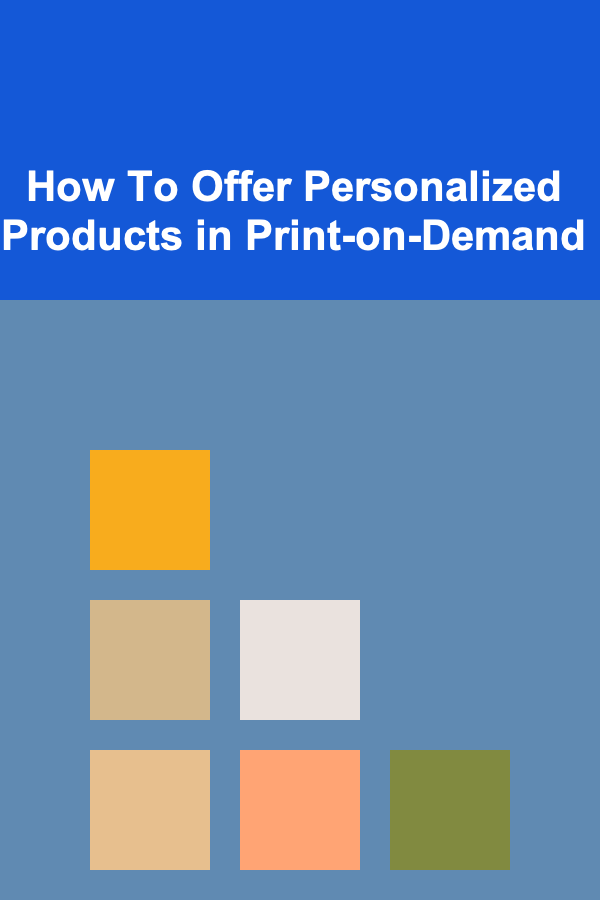
How To Offer Personalized Products in Print-on-Demand
ebook include PDF & Audio bundle (Micro Guide)
$12.99$8.99
Limited Time Offer! Order within the next:

In the rapidly evolving eCommerce world, offering personalized products has emerged as a powerful way to create a unique customer experience and stand out from the competition. Print-on-demand (POD) services have made it easier than ever for entrepreneurs to offer customized products without the need for large upfront investments or inventory management. By leveraging the power of POD platforms, sellers can allow customers to personalize products such as apparel, accessories, home goods, and more. This article explores the essential strategies for offering personalized products in the print-on-demand industry, from design to marketing.
Understanding Print-on-Demand (POD)
Before delving into the specifics of offering personalized products, it's important to understand the concept of print-on-demand. POD is a business model where products are printed and manufactured only after a customer places an order. This eliminates the need for upfront investment in inventory and allows entrepreneurs to offer a wide range of products without taking on the financial risk of unsold goods. POD is typically used for apparel, home décor, accessories, and even books or stationery.
The main advantage of POD is the ability to provide custom designs or personalized options to customers. In essence, it's a business model that aligns perfectly with offering personalized products.
The Appeal of Personalized Products
Personalized products cater to the growing demand for unique and one-of-a-kind items. Customers are increasingly looking for items that reflect their personalities, values, and individual tastes. Whether it's a custom-designed t-shirt, a mug with a meaningful quote, or a personalized piece of home décor, consumers are more willing to pay a premium for products that resonate with them on a personal level.
Offering personalized products also creates a sense of connection between the customer and the brand. Personalization goes beyond just a custom name on an item; it's about creating an experience that makes customers feel special and valued. In a world full of mass-produced goods, personalized products offer an emotional and tangible connection, which is why they have become so popular.
The Steps to Offering Personalized Products in Print-on-Demand
1. Select the Right POD Platform
Choosing the right print-on-demand platform is crucial when it comes to offering personalized products. There are numerous POD services available, each offering different customization options, products, and integrations. Popular platforms include Printful, Printify, Teespring, and Redbubble, among others. When selecting a platform, consider the following factors:
- Product Range: Does the platform offer a variety of products that can be personalized? Look for options such as apparel, home décor, accessories, and stationery.
- Customization Features: Does the platform allow for easy customization by the customer? Some platforms offer tools that let customers add their own text, images, or designs directly on the product.
- Quality Control: Ensure that the platform provides high-quality printing and materials to maintain customer satisfaction.
- Shipping and Fulfillment: Check the platform's shipping times and costs. Reliable fulfillment and prompt delivery are essential when offering personalized products.
- Integration with Your Store: Choose a platform that integrates smoothly with your eCommerce store, whether it's on Shopify, Etsy, WooCommerce, or other platforms.
2. Create a Seamless Customization Experience
One of the key aspects of offering personalized products is creating an easy and enjoyable customization experience for your customers. Here are some important considerations:
- Custom Design Tools: A good POD platform should provide easy-to-use design tools that allow customers to personalize products. These tools should be intuitive and accessible, even for customers with no design experience. Make sure that the platform allows for text customization (such as names or messages), image uploads, and even advanced features like color changes or product variations.
- Pre-designed Templates: While customization is key, offering pre-designed templates can also appeal to customers who may not know where to start. Offering customizable templates for various occasions (birthdays, weddings, holidays) can help attract a wide range of customers. These templates can serve as inspiration for personalized products, allowing customers to modify them as needed.
- Preview Feature: Allow customers to preview how their customized product will look before they place an order. This helps reduce mistakes and gives customers confidence in their purchase.
- Easy-to-Understand Instructions: Provide clear instructions for customers on how to customize their product. Whether it's adding a monogram, uploading an image, or adjusting colors, clarity is key to preventing confusion and ensuring a smooth process.
3. Offer a Wide Range of Products for Personalization
To capture a wide audience, you need to offer a diverse range of products that customers can personalize. Here are some popular categories that work well with POD:
- Apparel: T-shirts, hoodies, and sweatshirts are perennial favorites in the world of POD. Personalizing these products with names, quotes, or custom artwork is popular among customers for gifting or self-expression.
- Accessories: Bags, hats, and scarves are ideal for customization. These items offer more opportunities for design flexibility and personalization, making them a great addition to your product range.
- Home Décor: Pillows, blankets, canvas prints, and wall art are all excellent options for personalization. These products allow customers to add photos, quotes, or names to create a cozy, customized environment.
- Drinkware: Mugs, water bottles, and tumblers are frequently personalized gifts. Customers love the idea of giving unique drinkware as gifts or using it as a personal item.
- Stationery: Customized journals, notebooks, and planners are perfect for personal expression. Stationery items are popular for gifting, especially around holidays or special occasions.
Offering a wide range of products gives your customers more options and increases the likelihood of attracting a larger audience.
4. Develop a Strong Brand Identity
Personalized products are often tied to emotions and personal connections, so it's crucial to develop a brand that resonates with your target audience. Your brand identity should reflect the values and style that appeal to your customers. Here are some tips for developing a strong brand identity:
- Consistency: Ensure that your branding is consistent across all products, your website, and your marketing channels. This includes your logo, colors, fonts, and overall tone of voice.
- Niche Targeting: While personalized products have universal appeal, it helps to narrow down your focus. Whether it's gifts for pet lovers, custom sports apparel, or personalized wedding favors, finding a niche can help differentiate your business and attract a loyal customer base.
- Storytelling: Share the story behind your brand. Why did you start your POD business, and what motivates you to offer personalized products? Customers are more likely to connect with your brand when they feel like they are part of your journey.
5. Market Your Personalized Products Effectively
Once you've set up your store and curated your product range, it's time to market your personalized products. The key is to emphasize the uniqueness and emotional value of these products. Here are some effective marketing strategies:
- Social Media Marketing: Platforms like Instagram, Pinterest, and Facebook are visual-centric and perfect for showcasing your personalized products. Use high-quality images, customer testimonials, and videos to highlight the customizability of your products.
- Influencer Marketing: Collaborating with influencers can help you reach a wider audience. Find influencers who align with your brand and target demographic to showcase your personalized products.
- Email Marketing: Build an email list and use it to engage with potential customers. Send out personalized emails, offering exclusive deals, new product announcements, and reminders about the personalization options you offer.
- Search Engine Optimization (SEO): Ensure that your website and product listings are optimized for search engines. Use keywords like "customized gifts," "personalized apparel," or "custom home décor" to attract organic traffic.
- Seasonal Promotions: Personalization is especially popular during holidays and special occasions. Offer promotions or discounts during these times to boost sales.
6. Focus on Customer Service and Quality Assurance
Providing exceptional customer service is key to retaining customers and ensuring they have a positive experience with your personalized products. Here are some important points to consider:
- Clear Communication: Keep your customers informed at every stage of the process, from order confirmation to shipping. Provide tracking information and be responsive to customer inquiries.
- Quality Control: Personalized products should meet the highest quality standards. Ensure that the POD platform you choose uses top-tier printing methods and materials to deliver premium products.
- Handling Returns and Exchanges: While custom products are often non-returnable, offering excellent customer service and being transparent about return policies can help prevent dissatisfaction.
Conclusion
Offering personalized products through print-on-demand services is an exciting opportunity for entrepreneurs looking to tap into the growing demand for unique and customized items. By choosing the right POD platform, creating a seamless customization experience, offering a diverse product range, and developing an effective marketing strategy, you can build a successful personalized product business. The key to success lies in building a strong brand, providing high-quality products, and creating an emotional connection with your customers. With the right approach, you can offer personalized products that resonate with customers and help your business thrive in the competitive eCommerce landscape.

How Cutting Back on Eating Out Can Improve Your Health and Finances
Read More
How to Integrate Holiday-Themed Art into Your Home Decor
Read More
How to Invest in Real Estate as a Beginner
Read More
Mastering Conversion Rate Optimization: A Comprehensive Guide for Performance Marketing Managers
Read More
How to Research Marine Ecotoxicology
Read More
How to Prepare for Your Radiography Board Exams
Read MoreOther Products

How Cutting Back on Eating Out Can Improve Your Health and Finances
Read More
How to Integrate Holiday-Themed Art into Your Home Decor
Read More
How to Invest in Real Estate as a Beginner
Read More
Mastering Conversion Rate Optimization: A Comprehensive Guide for Performance Marketing Managers
Read More
How to Research Marine Ecotoxicology
Read More